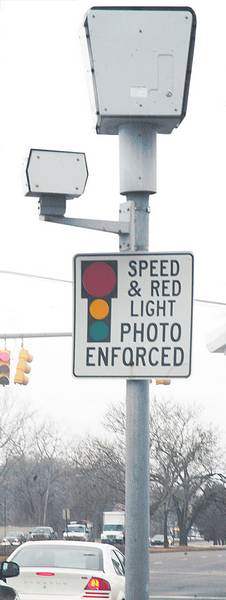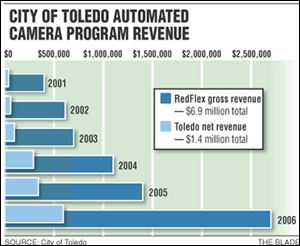
Traffic cameras face new hurdle
3/1/2007
Automated cameras at select intersections across Toledo have generated $1.4 million for the city since 2001.

Automated cameras at select intersections across Toledo have generated $1.4 million for the city since 2001.
The cameras that snap photos of speeders and red-light violators at high-risk intersections are praised by police for improving safety and reducing crashes.
But the future of the devices, which generate millions of dollars for Toledo and other communities throughout Ohio, is hinging on the outcome of class-action challenges before the state Supreme Court.
In taking up a request from a federal judge in Akron, the state's highest court could have the last word on whether municipalities have the authority to turn red light and speeding offenses from criminal to civil offenses.
The decision of the state Supreme Court will guide judges in lower courts handling litigation over the automated cameras, including two class-action lawsuits filed in Lucas County Common Pleas Court against the city of Toledo and RedFlex Traffic Systems, an Arizona subsidiary of an Australian company that installed and operates the digital cameras in Toledo.
At stake are millions of dollars in fines that the equipment generates for the communities.
Toledo keeps 25 percent of the $95 ticket. The remaining 75 percent goes to RedFlex. Since beginning the program at selected intersections in 2001, RedFlex has sent $1.4 million of the $6.9 million collected in fines to the city of Toledo.

So far, the speed and red-light cameras operated by RedFlex at intersections in Northwood in Wood County have not been challenged in court. The four cameras at two intersections and a mobile camera have generated $470,143 since April, 2005, Ad-ministrator Pat Bacon said.
The cities treat the traffic offenses as a civil violation, and opponents say that violates the state law that affords motorists to be cited by police officers who witnessed the act.
Samuel Kaplan, an attorney representing a Westerville, Ohio, woman in one of the Lucas County complaints, said Toledo's claim that cameras are allowed under the state constitution's home-rule authority conflicts with the statute that considers them criminal offenses.
"Under the law, the officer must witness and personally observe that you ran the red light. He must walk up to you, check your identification, and personally hand you the ticket. You also have the right to an attorney and the prosecution must prove its case,'' he said.
The lawsuit, which Mr. Kaplan filed in July, seeks a return of all the fine money paid since 2001 to RedFlex and the city as well as accrued interest and attorney fees.
In addition to Toledo, Akron, and Northwood, the cameras are used in Cleveland, Columbus, and Springfield, Ohio.
Because lower courts have delivered opposing opinions on several similar cases, U.S. District Judge David Dowd asked the state Supreme Court justices to rule on whether municipalities have the authority under home rule to enact civil fines for the offenses.
Judge Dowd is presiding over two related cases filed by motorists who are challenging Akron's automated camera program.
Perrysburg attorney Marshall Wisniewski represents a Toledo man who is challenging the constitutionality of Toledo's enforcement program.
Mr. Wisniewski, who filed class-action complaints last month in Lucas County Common Pleas Court, said violators are presumed guilty and denied their due-process rights.
"The law has always been and requires that law enforcement witness the offense. However, you are seeing the law moving away from that,'' he said. "What it boils down to is cash-register justice and injustice at its worst."
Last month, Michigan Attorney General Mike Cox issued an opinion that cameras cannot be used in that state to ticket drivers. The advisory ruling said only police officers who witness violations can write tickets.
In Toledo, where 26 cameras are placed at 18 high-risk intersections, police Chief Mike Navarre defends the automated speed and red-light cameras as effective tools in deterring motorists from violating traffic laws.
Chief Navarre said a very simple conclusion can be drawn: accidents will decline if people are not running red lights and speeding through intersections.
"Safety is the No. 1 issue. At every location where we have placed a camera, there has been a decrease in the number of violations at that intersection,'' he said. "If cities are doing it to make money, then they are doing it for the wrong reasons.''
John Madigan, acting Toledo law director, agreed with Chief Navarre that it is not about money.
"It is a system that works to deter motorists from speeding and running red lights. That is why I would hate to see it dismissed by the courts. It is not a money grabber, at least not here in Toledo," he said.
Before leaving office, Gov. Bob Taft vetoed a bill that would have banned cities from using the cameras to ticket drivers who speed unless a police office was present to witness the action.
Contact Mark Reiter at:
markreiter@theblade.com
or 419-213-2134.